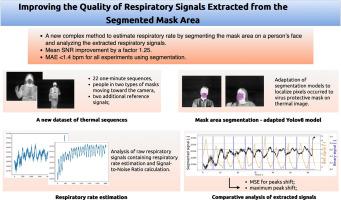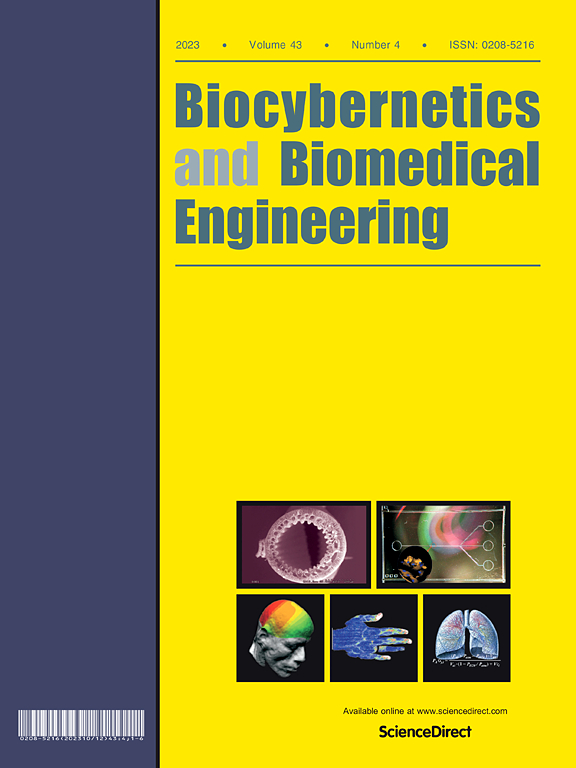Improving the quality of respiratory signals extracted from the segmented mask area
IF 6.6
2区 医学
Q1 ENGINEERING, BIOMEDICAL
引用次数: 0
Abstract
The COVID-19 pandemic has underscored the importance of wearing facial masks and monitoring respiratory health to prevent the spread of the virus. In this study, we developed a model for segmenting facial masks in thermal images. We applied the model to segment face masks in different conditions, including a person walking toward the observing camera. The segmented regions were further processed using different erosion masks to analyze the influence of the selected sources on the quality of the estimated respiratory signals. The Signal-to-Noise Ratio (SNR) was used as a quality measure. Additionally, the extracted respiratory signals were compared with two reference signals: binary signals generated by participants who signaled the inhalation phase and pressure signals measured with a respiratory belt. Our findings show a high level of concordance between the respiratory signals derived from the segmented mask region and those from the respiratory belt, validating the effectiveness of thermal imaging for capturing respiratory patterns. Notably, the signal-to-noise ratio (SNR) was higher for the segmented mask than the detection methods used in previous works. Specifically, for the mask segmentation task, the mean SNR improved by 4.3 compared to facial mask detection. The segmentation model achieved a mean Average Precision (mAP) of 0.992 for segmentation tasks and 0.857 mAP at the 50–95 % threshold using the Yolov8 “nano” architecture. This study underscores the potential of thermal imaging for non-invasive respiratory monitoring and highlights the explainability and accuracy of selecting the facial mask region for signal extraction.

提高了从分割的掩模区域提取呼吸信号的质量
COVID-19大流行凸显了戴口罩和监测呼吸道健康对防止病毒传播的重要性。在本研究中,我们开发了一个热图像中人脸的分割模型。我们将该模型应用于不同条件下的人脸分割,包括一个人走向观察相机。利用不同的侵蚀掩模对分割区域进行进一步处理,分析所选源对估计呼吸信号质量的影响。信噪比(SNR)作为质量度量。此外,将提取的呼吸信号与两种参考信号进行比较:参与者发出吸入相信号产生的二进制信号和呼吸带测量的压力信号。我们的研究结果显示,来自分段口罩区域的呼吸信号与来自呼吸带的呼吸信号高度一致,验证了热成像捕捉呼吸模式的有效性。值得注意的是,与以往的检测方法相比,分段掩码的信噪比(SNR)更高。具体来说,对于掩模分割任务,平均信噪比比人脸检测提高了4.3。使用Yolov8“nano”架构的分割模型,分割任务的平均平均精度(mAP)为0.992,在50 - 95%阈值下的平均平均精度(mAP)为0.857。本研究强调了热成像在无创呼吸监测中的潜力,并强调了选择面部面具区域进行信号提取的可解释性和准确性。
本文章由计算机程序翻译,如有差异,请以英文原文为准。
求助全文
约1分钟内获得全文
求助全文
来源期刊

Biocybernetics and Biomedical Engineering
ENGINEERING, BIOMEDICAL-
CiteScore
16.50
自引率
6.20%
发文量
77
审稿时长
38 days
期刊介绍:
Biocybernetics and Biomedical Engineering is a quarterly journal, founded in 1981, devoted to publishing the results of original, innovative and creative research investigations in the field of Biocybernetics and biomedical engineering, which bridges mathematical, physical, chemical and engineering methods and technology to analyse physiological processes in living organisms as well as to develop methods, devices and systems used in biology and medicine, mainly in medical diagnosis, monitoring systems and therapy. The Journal''s mission is to advance scientific discovery into new or improved standards of care, and promotion a wide-ranging exchange between science and its application to humans.
 求助内容:
求助内容: 应助结果提醒方式:
应助结果提醒方式:


